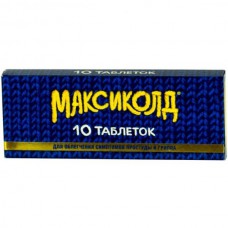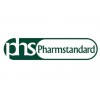Expiration date: 01/2026
Dosage form: film-coated tablets
Composition per tablet:
Active substance:
aracetamol 500 mg, phenylephrine hydrochloride 10 mg, ascorbic acid 30 mg,
Auxiliary substance:
Core: croscarmellose sodium 28 mg, calcium hydrogen phosphate 97, 92 mg, ethyl cellulose 0, 2 mg hyprolose (hydroxypropyl cellulose (EF Klucel)) 19, 7 mg, magnesium stearate 7 mg, talc 7 mg, colorant sunset yellow (E 110) 0, 18 mg, until the core mass of 700 mg.
The shell: polymer (hydroxypropyl methylcellulose) 13, 2 mg, hyprolose (hydroxypropyl cellulose (EF Klucel)) 7, 701 mg talc 6, 3 mg, titanium dioxide 2, 75 mg, colorant sunset yellow (E 110) 0, 049 mg to obtain tablets, film-coated, weighing 730 mg.
Description
Tablets, film-coated pinkish-orange, oval biconvex with risk. On the cross section of the tablet pinkish-orange with white and orange inclusions.
Pharmacological properties
The combined drug, has antipyretic and analgesic effect, is designed to relieve the symptoms of "cold" and flu.
The action of the drug is due to the properties of its constituent components.
Paracetamol-non-narcotic analgesic, has antipyretic and analgesic effect, due to the blockade of cyclooxygenase in the Central nervous system and the impact on the centers of pain and thermoregulation. Reduces headache, muscle pain, fever phenomenon.
Phenylephrine – alpha-1-agonists has little influence on beta-adrenergic receptors of the heart, is not a catecholamine. It causes narrowing of arterioles, thereby reducing swelling and hyperemia of the nasal mucosa, facilitates breathing through the nose.
Ascorbic acid-increases the body's resistance to infections, replenishes the increased need for vitamin C in colds and influenza.
Indications
Symptomatic treatment of infectious and inflammatory diseases (including influenza and other acute respiratory viral infections (SARS)), accompanied by fever, chills, nasal congestion, headache, bone and muscle pain, in the throat and sinuses.
Contraindications
Hypersensitivity to any component of the drug, severe renal / hepatic insufficiency, hyperthyroidism (including thyrotoxicosis), heart disease (severe aortic stenosis, acute myocardial infarction, tachyarrhythmia), hypertension, simultaneous administration of tricyclic antidepressants, beta-blockers, monoamine oxidase inhibitors, including during the 14 days after cancellation, concomitant use of other paracetamol-containing drugs and remedies to relieve symptoms of "cold", flu and nasal congestion, prostatic hyperplasia, angle-closure glaucoma, children (up to 9 years, as well as children with a body weight of less than 30 kg).
Used with caution
With a deficiency of glucose-6-phosphate dehydrogenase, with benign hyperbilirubinemia, during pregnancy and lactation, in the elderly.
Dosage and administration
Inside, before meals or 1-2 hours after meals, drinking plenty of liquid.
Adults and children over 12 years (body weight over 40 kg): 1-2 tablets every 4-6 hours. The frequency of admission is not more than 4 times a day with an interval of at least 4 hours.
Children aged 9 to 12 years (body weight more than 30 kg): 1 tablet every 4-6 hours. The frequency of admission is not more than 4 times a day with an interval of at least 4 hours.
The drug is not recommended for use more than 5 days as an analgesic and 3 days as a antipyretic without consulting a doctor. If symptoms persist, you should consult a doctor.
DO NOT EXCEED INDICATED DOSE.
Side effect
Allergic reactions are possible (skin rash, skin hyperemia, urticaria, angioedema).
Paracetamol: hematopoietic disorders (anemia, thrombocytopenia, methemoglobinemia).
Phenylephrine: headache, nausea or vomiting, angina, bradycardia, shortness of breath, increased or decreased blood pressure, heartbeat, tachycardia, ventricular arrhythmia (especially when used in high doses), irritability, motor anxiety, allergic reactions.
Ascorbic acid: may cause irritation of the mucous membrane of the gastrointestinal tract, with long-term use of large doses – nausea, vomiting, diarrhea, hyperacid gastritis, ulcerative of the mucous membrane of the digestive tract, reducing capillary permeability (possible deterioration of trophic tissues, increased blood pressure, hypercoagulability, the development of microvascular complications). It is also possible the occurrence of thrombocytosis, hyperprothrombinemia, erythropenia, neutrophilic leukocytosis, hypokalemia, glucosuria, inhibition of the function of the insulin apparatus of the pancreas.
With long-term use in doses much higher than the recommended, increases the likelihood of impaired renal function (moderate pollakiuria, hyperoxaluria, nephrolithiasis, damage to the glomerular apparatus of the kidneys), increased excitability of the Central nervous system, headache, insomnia.
In case of adverse reactions, consult your doctor.
Overdose
In case of overdose, seek medical attention immediately, even if you feel well, as there is a risk of delayed signs of serious liver damage.
In overdose, symptoms are usually caused by exposure to high doses of paracetamol.
Symptoms: during the first 24 hours after administration - pale skin, nausea, vomiting, anorexia, abdominal pain, glucose metabolism, metabolic acidosis. Symptoms of liver dysfunction may appear after 12-48 hours after an overdose. In severe overdose-liver failure with progressive encephalopathy, coma, death, acute renal failure with tubular necrosis (including in the absence of severe liver damage), arrhythmia, pancreatitis. Hepatotoxic effect in adults is manifested when taking 10 g or more.
Treatment: the introduction of aid donors SH-groups and precursor to the synthesis of glutathione - methionine for 8-9 hours after the overdose and acetylcysteine within 8 h. the Need for additional therapeutic measures (further introduction of methionine, in/in the introduction of acetylcysteine) is determined depending on concentration of paracetamol in the blood, and the time elapsed after its reception.
Interaction with other drugs
The drug increases the effects of monoamine oxidase inhibitors, sedatives, ethanol.
The risk of hepatotoxic paracetamol increases with simultaneous administration of ethanol, hepatotoxic drugs, inducers of enzymes of microsomal oxidation in the liver (phenytoin, barbiturates, rifampicin, phenylbutazone, tricyclic antidepressants, etc.).
Concomitant use of paracetamol in high doses increases the effect of anticoagulant drugs (reduced synthesis of procoagulant factors in the liver). Paracetamol reduces the effectiveness of uricosuric drugs.
Prolonged use of barbiturates reduces the effectiveness of paracetamol. Metoclopramide and domperidone increase, and colestyramine reduces the rate of absorption of paracetamol. Inhibitors of enzymes of microsomal oxidation (including cimetidine) reduce the risk of hepatotoxic action of paracetamol.
Simultaneous administration of ethanol and paracetamol contributes to the development of acute pancreatitis. Prolonged combined use of paracetamol and non-steroidal anti-inflammatory drugs increases the risk of "analgesic" nephropathy and renal papillary necrosis, onset of end-stage renal failure. Simultaneous long purpose of paracetamol in high dozes and salitsilatov raises risk of development of kidney cancer or urinary bladder. Was diflunisal increases the plasma concentration of paracetamol on 50% - risk of hepatotoxicity. Myelotoxic drugs enhance the manifestations of hematotoxicity of paracetamol.
Phenylephrine reduce gipotenzivny effect of diuretics and antihypertensive drugs (including methyldopa, mecamylamine, guanadrel, guanethidine), reduce antianginalny effect nitrates.
Phenothiazines, alpha-blockers (phentolamine), furosemide and other diuretics reduce hypertensive effect feniramina. Monoamine oxidase inhibitors (including furazolidone, procarbazine, selegiline), oxytocin, ergot alkaloids, tricyclic antidepressants, methylphenidate, agonists enhance the vasoconstrictor effect and aritmogennosti fenilafrina, on the background of reserpine for possible hypertension. Ergometrine, ergotamine, methylergometrine, oxytocin, doxapram increase the severity of the vasoconstrictor effect of Pheniramine.
Inhalation anaesthetics (e.g. chloroform, enfluran, halothane, isoflurane, penthrane) increase the risk of severe atrial and ventricular arrhythmias. Thyroid hormones increase (mutually) the effect of phenylephrine and the associated risk of coronary insufficiency (especially in coronary atherosclerosis).
Ascorbic acid increases the concentration in the blood of benzylpenicillin and tetracycline, reduces the effectiveness of heparin and indirect anticoagulants, increases the overall clearance of ethanol, which in turn reduces the concentration of ascorbic acid in the body, reduces the therapeutic effect of antipsychotic drugs (neuroleptics) - phenothiazine derivatives, tubular reabsorption of amphetamine and tricyclic antidepressants.
While the use of acetylsalicylic acid increases urine excretion of ascorbic acid and reduced excretion of acetylsalicylic acid. Acetylsalicylic acid, oral contraceptives, fresh juices and alkaline drink reduce absorption and absorption of ascorbic acid.
Ascorbic acid improves intestinal absorption of iron preparations increases the risk of christallurii in treating salicilatami and short-acting sulfonamides, inhibits the renal excretion of acids increases the excretion of drugs, having an alkaline reaction (including alkaloids), reduces the blood concentration of oral contraceptives, reduces chronotropic effect of isoprenaline. With long-term use or use in high doses may interfere with the interaction of disulfiram and ethanol, in high doses increases the excretion of mexiletin kidneys.
Quinoline series drugs, calcium chloride, salicylates, glucocorticoids with long-term use Deplete reserves of ascorbic acid. Barbiturates and primidone increase excretion of ascorbic acid in the urine.
Special instruction
Before taking the drug, a doctor's consultation is necessary in the case of concomitant administration of metoclopramide, domperidone, colestyramine (due to the fact that metoclopramide and domperidone increase, and colestyramine reduces the rate of absorption of paracetamol), anticoagulants (since concomitant use of paracetamol in high doses increases the effect of anticoagulant drugs).
The drug distorts the results of laboratory tests that evaluate the concentration of glucose and uric acid in plasma.
When using the drug for more than 5-7 days, peripheral blood parameters and the functional state of the liver should be monitored.
The use of the drug during pregnancy is possible only on the prescription of a doctor.
IN ORDER TO AVOID TOXIC LIVER DAMAGE THE DRUG SHOULD NOT BE COMBINED WITH RECEPTION OF ALCOHOLIC BEVERAGES, AND TO TAKE PERSONS WITH CHRONIC ALCOHOLISM.
The drug does not have a negative impact on the performance of potentially hazardous activities that require special attention and rapid reactions.
Form release
Tablets, film-coated
2, 10 or 12 tablets in a contour cell package of polyvinyl chloride film and aluminum foil printed lacquered.
1 or 2 contour cell packaging with instructions for use in a pack of cardboard.
Storage conditions
In a dry place at a temperature not exceeding 25 °C.
Keep out of reach of children!
Shelf life
2 years.
Do not use after the expiration date specified on the package.


